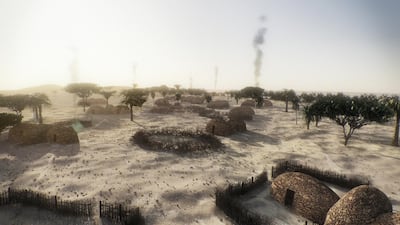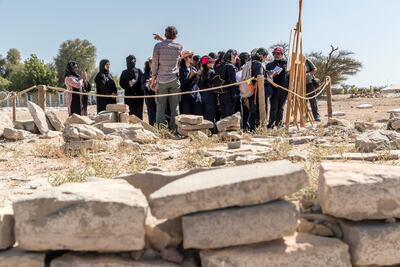A Stone Age village that revealed a sophisticated and skilled settlement from 8,000 years ago. A Bronze Age site in Al Ain that could be the first agricultural village in Arabia and the discovery of the earliest-known mosque in the UAE.
Work by archaeologists at sites across Abu Dhabi during 2018 are radically reshaping our understanding of what life was like here thousands of years ago.
About six major excavations, along with a number of smaller test digs and survey work, were undertaken by Abu Dhabi’s Department of Culture and Tourism this year. More than 20 archaeologists spent weeks in the field, digging, surveying, cataloguing and analysing.
Under the guidance of head archaeologist, Peter Magee, sites are now being looked at within a broader context. Were settlements linked? Did people know about each other? Are people plugged into wider networks?
“We can turn the microscope up to look at objects but we also pull it back and look at the big picture and an interesting picture is now emerging,” he said.
Marawah Island is one site that is challenging perceptions about the people who lived here thousands of years ago. This was a period when humans first started to live in one place and grow crops, but Marawah has its own distinctive flavour.
“The people who lived there used the sea as a superhighway. They were super intelligent,” said Mr Magee. “They fished. You had pearling, trade, boat technology and navigation. All of this is kicking off.

“I believe it will fundamentally change the way we think about the ancient UAE and about the Neolithic age globally as it shifts our focus away from traditional models of agriculture and settlement.”
The work in Abu Dhabi also focuses on the Bronze Age. Hili 8 is part of Al Ain's Unesco world heritage sites and is reputed to be the earliest agricultural village in Arabia. Radio carbon dating and a flotation device that sifts through soil and seeds to determine what crops were growing here 5,000 years ago are just some of the methods deployed by DCT archaeologists during to verify this theory.
“These people always kept their options open. They are not just growing cereal crops such as wheat or barley, they also hunted animals. It was a very flexible and intelligent way to approach these environments.”
Hili 14 is a large fortified building from the Bronze Age in Al Ain. Archaeologists are using GPS, satellite data and advanced computer programmes to examine the transformation in the landscape around the building. These buildings were filled in with sand and abandoned so the archaeologists are in search of answers.
A closer look at the falaj irrigation system was also made at another Iron Age site in Al Jabeeb. Now the site is just a series of rolling dunes, but 3,000 years ago people saw an opportunity to grow things here. No one knows why the site was abandoned.
Mr Magee says once these early communities learnt how to develop the falaj, it reappeared elsewhere when the conditions were right. The falaj system also links to the early Islamic period. In September, archaeologists revealed the discovery of a 1,000-year-old mosque in Al Ain, which is believed to be the earliest discovered. A falaj system was found nearby.
“This shows the long range of human occupation where people pick up technology and do not always use it, but it goes into a community toolkit. And as the environment changes, or when they move to a different area, they redeploy part of that toolkit and a falaj system is like that.”
Mr Magee has been working in the UAE for close to 25 years and with the DCT for the past two. His work has always sought to look at the bigger picture and now that approach is beginning to bear fruit.
“We can have sites and nice objects, but now we are seeing all this coming together to form a big narrative to tell the ancient history of the country. That’s very exciting."
_______________
Read more:
Archaeologists uncover UAE's earliest mosque at Al Ain site
Three new elephant trackways discovered in Abu Dhabi, archaeological conference reveals
Marawah Island: Life in Abu Dhabi's Stone Age village was far from nasty, brutish and short



